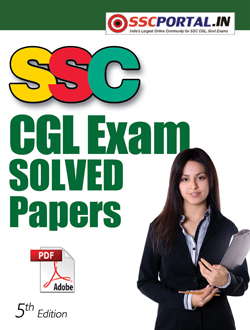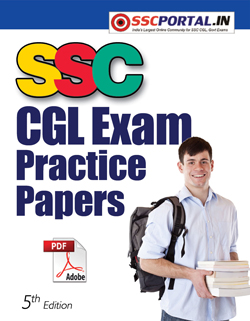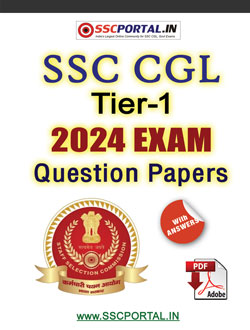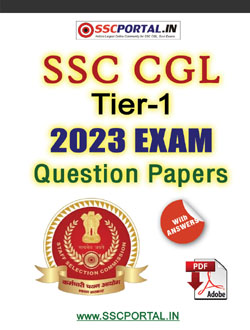NEW! SSC CGL PDF NOTES
SSC CGL MCQ : Geography
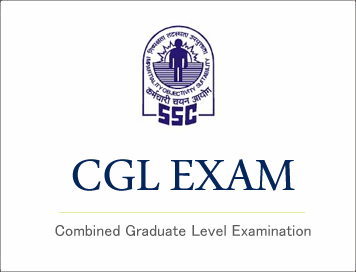
SSC CGL MCQ : Geography
1. The study of heavenly bodies is known as:
(a) Astrology
(b) Astronautics
(c) Astronomy
(d) Astrophysics
2. Comets revolve around:
(a) sun
(b) earth
(c) venus
(d) no single heavenly body
3. Which two planets of the solar system have no satellites ?
(a) Mercury and Venus
(b) Venus and Mars
(c) Mercury and Pluto
(d) Venus and Neptune
4. The planet having eight moons is :
(a) Venus
(b) Mars
(c) Uranus
(d) Neptune
5. The hottest planet is :
(a ) Mercury
(b) Venus
(c) Jupiter
(d) Saturn
6. Which of the following is the brightest planet?
(a) Mercury
(b) Venus
(c) Mars
(d) Jupiter
7. Which of the planets is nearest to the earth?
(a) Jupiter
(b) Venus
(c) Mercury
(d) Mars
8. Which planet is known as the Earth’s Twin ?
(a) Venus
(b) Mars
(c) Uranus
(d) Neptune
9. Which one of the following planets takes the same number of days for rotation and revolution ?
(a) Mars
(b) Venus
(c) Mercury
(d) Jupiter
10. Which of the following planets is known as ‘Morning Star’?
(a) Mercury
(b) Venus
(c) Mars
(d) Jupiter
11. Which planet looks reddish in the night sky ?
(a) Mercury
(b) Mars
(c) Jupiter
(d) Saturn
(E-Book) SSC CGL (Tier-1) Exam 2020 Solved Question Papers PDF Download
12. Match the following :
A. Largest Planet 1. Pluto
B. Brightest Planet 2. Jupiter
C. Densest Planet 3. Earth
D. Smallest Planet 4. Venus
A B C D
(a) 2 3 4 1
(b) 2 4 3 1
(c) 3 4 1 2
(d) 3 4 2 1
13. The exact time taken by the earth for single rotation on its own axis is :
(a) 24 hrs
(b) 24 hrs 35 sec
(c) 23 hrs 50 minutes 7.2 sec
(d) 23 hrs 56 minutes 4.09 sec
14. Match the following
Planet Gases in atmosphere
A. Venus 1. Hydrogen and helium
B. Mars 2. Hydrogen, helium ammonia, methane
C. Saturn 3. Carbon dioxide, amonia and methane
D. Jupiter 4. Carbon dioxide and nitrogen
A B C D
(a) 4 3 1 2
(b) 2 3 4 1
(c) 4 2 3 1
(d) 2 1 4 3
15. A blackhole is a :
(a) contracted star with intense gravitational pull
(b ) 6star with very low surf act temperature
(c) star with no atmosphere
(d) pulsating star
16. Ursa Minor is:
(a) the name of an island
(b) a group of stars
(c) the name of a satellite
(d) the name of a star
17. Asteroids have their orbits between the planets :
(a) Mercury and Venus
(b) Earth and Mars
(c) Mars and Jupiter
(d) Jupiter and Saturn
18. Hailey’s comet appears once in a period of:
(a) 24 years
(b) 32 years
(c) 76 years
(d) 84 years
19. Stars which appear single to the naked eye but are double stars when observed by a telescope, are known as :
(a) cosmic stars
(b) quasars
(c) binaries
(d) novae and supernovae
20. What are Sun spots ?
(a) Regions on earth without winter climate
(b) Desert areas on the sun
(c) Dark patches on the surface of the sun which are cooler areas
(d) Dark patches on the surface of the Sun resulting from a localised fall in the temperature to about 4000 K
21. The brightest star in the sky is:
(a) Alfa Centauri
(b) Proxima Centauri
(c) Sirius
(d) Sun
22. The outermost layer of Sun Is called:
(a) convection zone
(b) photosphere
(c) chromospheres
(d) corona
23. ‘A star which appears blue’ is :
(a) cooler than the moon
(b) hotter than the sun
(c) as hot as the sun
(d) cooler than the sun
24. Lunar Sea refers to :
(a) a small sea on the moon
(b) a sea on earth which experiences high tides due to gravitational attraction of the moon
(c) a dark plain on the moon
(d) a light water body illuminated by the moon-light
25. ‘The sunspots cause :
(a) aurora borealis and aurora australis
(b) magnetic storms on the surface of the sun
(c) polar auroras
(d) all of these
26. The Milky way extends through a distance of :
(a) 1 light year
(b) 8 light years
(c) 105 light years
(d) 1010 light years
27. The period of one revolution of sun around the centre of galaxy is called :
(a) Parsec
(b) Astronomical year
(c) Cosmic year
(d) Light year
28. Super Nova is :
(a) an asteroid
(b) a black hole
(c) a comet
(d) a dying star
29. How many years does Pluto take in revolving round the Sun?
(a) 110 years
(b) 246 years
(c) 248 years
(d) 250 years
30. Twelve constellations referred to as zodiac are :
(a) signs of Roman gods
(b) imaginary region that encompass the path of the planets
(c) a group of stars
(d) none of these
31. Which of the following celestial bodies bear, The Sea of Tranquility’ and ‘The Ocean of Storms’ ?
(a) Mars
(b) Venus
(c) Moon
(d) Sun
32. The time required by moonlight to reach the earth is :
(a) 1 sec
(b) 1.3 sec
(c) 2 sec
(d) 2.3 sec
33. Match the following :
A. Ursa Major 1. Star
B. Sirius 2. Constellation
C. Milky Way 3. Satellite
D. Titan 4. Galaxy
5. Planet
A B C D
(a) 1 2 3 4
(b) 1 2 4 3
(c) 2 1 4 3
(d) 2 4 1 3
34. The Solar Corona mainly consists of :
(a) cosmic rays
(b) molten lava
(c) gases
(d) ice
35. The temperature of the Sun s outer surface is :
(a) 60,00,000° C
(b) 6000º C
(c) 60° C
(d) 0ºC
36. The shape of our milky way galaxy is :
(a) circular
(b) elliptical
(c) spiral
(c) none of the above
37. Among the following which planet takes maximum time for one revolution around the Sun?
(a) Earth
(b) Jupiter
(c) Mars
(d) Venus
38. Which of the following gases is most predominant in the Sun?
(a) Helium
(b) Hydrogen
(c) Nitrogen
(d) Ozone
39. Moon is called a satellite of the earth because:
(a) it is much smaller than the earth
(b) it has no light of its own
(c) it revolves round the earth
(d) it produces tides on the earth


